- Read
about the different type of handloom sarees of Maharashtra and Goa along with
pictures.
The
distinct mix of various cultures has shaped the people of Maharashtra into a land
of prosperity and spirituality. Maharashtra was also the land of the great
warriors who have left behind grandeur, high spirits and exuberance. All these
features add to the rich culture and heritage to the Marathas.
Maharashtra
has a wide range of textiles, of varied designs, that are manufactured using different
techniques. The specialty in the weave in each region is developed based on
location, climate and cultural influences. Primarily used fabrics like cotton
and silk are best suited to the climate of Maharashtra.
We
present the different saree types of Maharashtra.
KHUN Saree
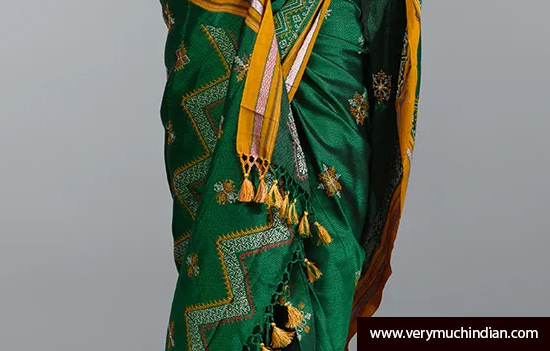
This
is a silk-cotton blended saree with a traditional woven resham border. The
saree typically has a cotton body and mostly art silk, or in some cases pure
silk is used in the border and pallu. In a few variations, the weavers may
include an art silk warp in the body as well. The folding pattern of the fabric
into small squares has earned the name Khuna or Khun.
It
is lightweight cotton or cotton-silk fabric, which has an intricate brocade
pattern. The saree has small motifs all over the body, which gives an overall
aesthetic appeal to the saree.
The
journey of a 4000 old tradition has been recently revived by fashion experts,
to bring back the same much-celebrated fabric into vogue. The fabric was worn
by royalty and and is also offered to Gods. The workmanship is laborious. It a
lot of dedication, patience, and passion to craft a perfect Khun saree.
Good
read
Or read Here
Or Video shows different type
of sarees
PAITHANI Saree
 Paithani Saree at shop in Paithan.
Paithani Saree at shop in Paithan.
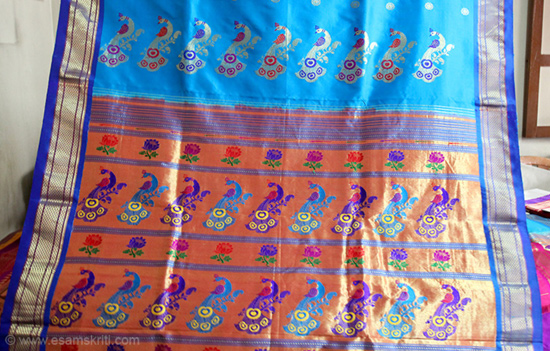 Paithani Saree at shop in Paithan.
Paithani Saree at shop in Paithan.
Paithani
is a variety of sari, named after the Paithan town in Aurangabad, Maharashtra
State in India where the sarees are woven by hand. Made up of very fine silk
fabric, it is considered one of the richest saris in India.
Even in today's advanced world the methods of weaving Paithani silk sarees have not changed from 200 B.C. The art is more than 2,000 years old, developed in Paithan (Pratishthan) capital of the legendary Satavahanas Ruler. Satavahana's ruler used to export cotton and silks to the Roman Empire in exchange for gold.
During the Mughal era Aurangzeb patronized the weavers and the designs were known as "Aurangzebi". He prohibited the weavers to weave 'Jamdanis ' except for his court. Peshwas were great patrons of Paithani.
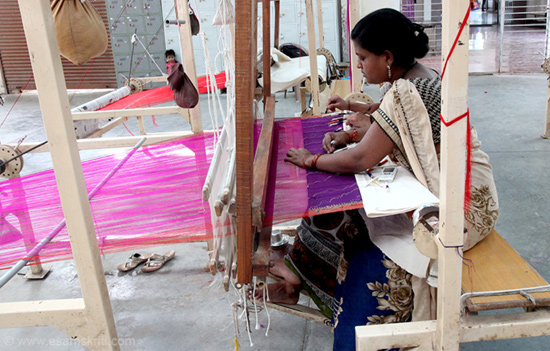 Saree being made at training centre run by government at Paithan.
Saree being made at training centre run by government at Paithan.
Industrial Revolution Impact
Sadly,
the Paithani weaving industry experienced a huge setback with the Industrial
Revolution and the advent of the British Rule. But during the 17th century, the
Peshwas took it upon themselves to promote the craft and consequently, settled
Paithani weavers in Yeola, which is now the manufacturing hub for Paithani Silk
Sarees in India.
The
Paithani Sarees & Fabric is socio-culturally related to Maharashtrian people
due to its confluence with their culture. Until the 17th century, weaving
activities were limited to Paithan town. Later weaving was transferred to Yeola
(a village in Nashik district). The sale of Paithani saree started coming up in
1984-85 and the Yeola village became the main commercial center of Paithani
weaving.
Despite
the lustrous history of Paithani sarees, today they are in a similar state as
many handloom sarees are made thanks to the power of looms.
However,
no machine-made fabric can be compared with the hand-made Paithani sarees. Even
today Maharashtra is the home of the most celebrated textile like the Paithani
saree, gold-embroidered zari sari with its beautiful designs and woven borders.
U
can see more sarees Here
or Here
To
see esamskriti album of sarees for sale in Paithani, Aurangabad and how they
are made click Here
KARVATI Saree
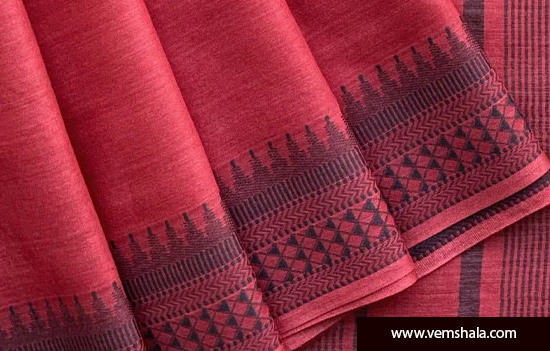
In
earlier days, handloom weavers of village Andhalgaon, Mohadi and Palandur
District Bhandara, part of Vidarbha region in Maharashtra produced cotton
gamchha with 20s cotton yarn in warp and weft having two side Karvati border
(Solid border).
Karvat in Marathi is the
saw and since the designs look like saw tooth, the fabric is known as Karvati
or Karvatkati. District Bhandara is a tasar cocoon producing area. Having
plenty of raw material the weavers introduced tasar material in weaving of
Tasar Karvati Saree.
Material Used
The
tasar is wild natural silk obtained from a wide wing moth that is yellowish
brown in colour. The tasar produced in the Vidarbha region of Maharashtra is
supposed to be best in quality and colour due to unique environmental
conditions of this region. It is mostly tribals who are traditionally doing the
job of protecting cocoons on trees in forests. The tasar yarn so obtained is
used for production of sarees.
Technique applied
The
Tasar Karvati Saree is woven with three shuttle weaving (tapestry type of
weaving technique) to have solid colour border and body. The border is woven
with mercerized cotton yarn and pure tasar hand reeled yarn.
The saree is woven on pit loom mounted with Nagpuri wooden lattice dobby on the top of the loom above the weaver’s seat. The uniqueness of the Tasar Karvati saree is that the border is woven with various temple designs in different sizes. The traditional motifs are woven with extra warp threads controlled by lattice dobby.
How to distinguish
1.
Hand reeled tasar is used. Fabric appearance is not flat and uniform. There are
uneven picks in irregular fashion.
2.
Feel is harsh and the colour is darker beige
3.
Saw tooth designs of various sizes are woven in the border of the saree in
tapestry technique.
To
see sarees click Here
or Here
HIMROO Saree
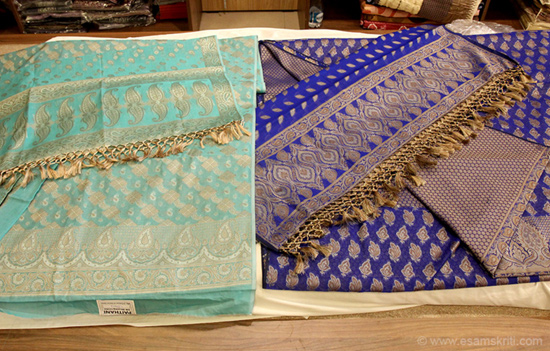 Saris at Aurangabad shop, Paithani Silk Weaving Centre.
Saris at Aurangabad shop, Paithani Silk Weaving Centre.
Himroo
is a fabric made of silk and cotton, which is grown locally in Aurangabad.
Himroo was brought to Aurangabad during the reign of Mohammad Tughlaq, when he
had relocated his capital from Delhi to Daulatabad near Aurangabad.
The word Himroo comes from Persian word “Hum–Ruh” which means “similar”. Himroo is a replication of Kinkhwab, which was
woven with pure golden and silver threads in olden days, and meant for the
royal families. However, some historians believe that Himroo was the innovation
of local craftsmen with very little Persian influence.
Himroo uses
Persian
designs, and is distinctive in appearance. Himroo from Aurangabad is in demand
for its unique style and design.
Himroo
is a type of extra-weft manufactured ordinarily from cotton and viscose rayon
yarn on a cotton ground. It is also woven from silk yarn and gold thread on a
silk ground giving it a satiny sheen. The design is decided at the outset since
two kinds of threads are mixed. This handloom has historically been produced in
Aurangabad. These fabrics denoted nobility and royalty in olden times.
To
read blog on Himroo
or see Himroo pure
Cotton sarees
SOLAPURI Saree

The saree is vibrant and rich in color. It’s light in weight and comfortable to wear.
The
product is designed by artisans from Padmashali
community. The community is originally a Telugu speaking artisans, engaged in
weaving. They migrated to different surrounding regions like Kerala,
Maharashtra, Karnataka, Telangana, and Tamil Nadu.
Solapuri chaddar

A Solapuri
chaddar is a cotton bed sheet made in Solapur city. These
bed sheets are popular in India where they are manufactured using hand
looms and are known for their design and durability. Solapuri chaddars
were the first product in Maharashtra to obtain Geographical
Indication (GI) status.
To
see chaddar click here
Or here
NAGPURI Saree

Lovely,
light and elegant is the soft cotton saree from Nagpur. These saris are woven
on pit-looms mainly with pure cotton yarn. The special feature of the Nagpur
saris are designs that are woven with the Nagpuri wooden dobby. The variety
includes plain sarees with the characteristic borders or designs woven in
stripes and checks with fly shuttles, complimenting the finely textured body
with richly attractive borders.
These
sarees are immensely famous for colourful stripes and vibrant prints with
intricate embroidery on their thick borders. These handwoven sarees come in
different vibrant colours, including brown, magenta, red, green, blue and many
more. Redefine beauty with simplicity by wearing these handwoven artisanal
sarees that reflect the hard work of the talented and hardworking expert
craftsmen across the length and breadth of India.
Handwoven
cotton clothing from Nagpur is widely famous for its lighter weight and elegant
appearance, with the distinctive colours and patterns adding to its beauty. The
traditional Nagpuri cotton sarees are manufactured in pure cotton yarn on
pit-looms and Nagpuri wooden dobby. Credits
PUNERI Saree
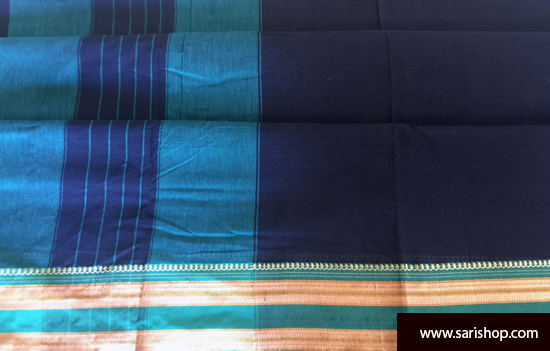
Puneri
cotton is one of the most prominent weaves of Maharashtra and an emblematic
cloth of Pune.
This
textile owes much of its fame to the cotton and silk weaving industries that
flourished throughout the state at the onset of the 19th century. It may be
demure and virginal in appearance but boasts a long-standing history. It takes
one back to the era of the spirited Marathas and Peshwas, Puneri cotton is a
canvas of modest elegance.
Puneri
cotton is predominantly used to weave saris, although its modern renditions see
it being incorporated into salwars and kurtas too.
The
weave is said to have travelled to Maharashtra from Karnataka and Andhra
Pradesh. During the heydays of the Peshwa Empire, the sari was mainly worn by
women of the royal household, and on certain occasions, was delicately woven
with silk.
The
base fabric is crafted with 100% cotton, with the warp (where the yarn is
placed in a longitudinal position) and weft (where the yarn is interlocked with
the warp at a right angle, running back and forth alongside it) technique. The
sari, which is otherwise quite austere, is accentuated by
a zari (metallic-colored) border. It is particularly intriguing to
chart the journey of this much-coveted hem. It speaks of immense cultural
significance-characterised by dainty triangular motifs, the border stands as a
testimony to the intricate temple architecture which was typical of ancient
Pune.
The
border comes with its own variants, such as Gomi,
Nav Bharat, Jijamata and Rudraksh,
each illustrating a design which is distinctly its own. This border is often
created using the extra-warp technique. Considered supplementary to the body of
the fabric, this technique includes insertion of the additional warp into the
sari in a way that does not disrupt the primary weaving process. The sari is
usually woven with a yarn count of 100s, and features a tok padar,
a pallu woven with vertical lines.
Maharashtrian NAUVARI Saree
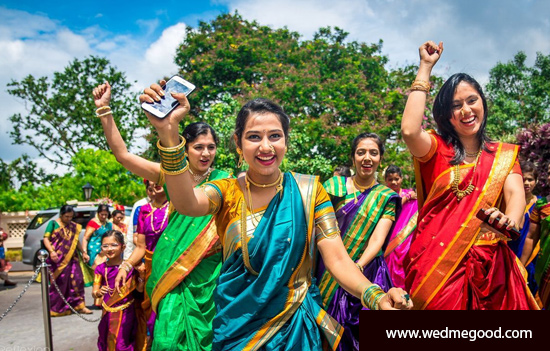
The
history and origin of the saree are shrouded in mystery, but the archaeological
sculptural references of earlier civilizations show the saree being draped
like kacham or
a dhoti by both genders.
The distinctive Maratha woman’s apparel is referred to as Nauvari, meaning nine yards. It is also called as the Kaashtha sari or Lugade. The name Kaashtha sari
is because the style of draping the saree is similar to the way a Maharashtrian
dhoti is worn.
The
nine yards saree today is worn by ladies purely on ceremonial occasions. The
style of draping this saree in the Deccan region varies from caste and
community. For example, the style of draping by the Brahmin community is with
the hind pleats tucked into the waist at the back-centre and pallu is thrown
across the left shoulder. The tribal women wear it high up to their knees and
the coastal fisherwomen drape it like a kacham
which allows for easy movement.
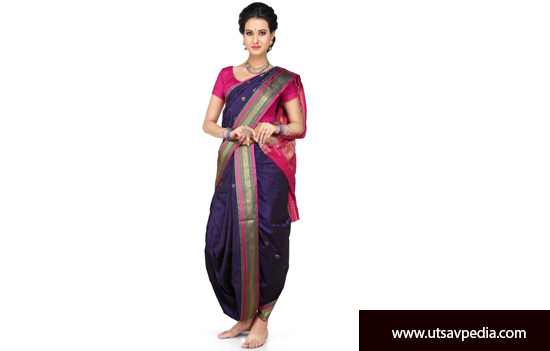
One
of the most interesting features of the Nauvari or
the lugade is the indigenous design palette in weaving, which is
untouched by Moghul motifs or techniques.
The
distinguished painter of the 19th century, Raja
Ravi Varma selected the nine- yards saree which portrayed the best dresses for the various goddess he was commissioned to paint. The historical figure of Rani Lakshmibai of Jhansi or Jijabai, the Maratha queen provides us with visual images of how women adapted this garment into the garb of a warrior.
The
variety of designs, drapes, fabrics and colours in sarees reveal a unique
blending of religious and cultural influences of India. And the drape of the
saree across the geographical diversity of India is a visual language in
itself!
To
see lovely bride designs
Or read a good
blog with pics Or How to wear a Nauvari Saree video
6 minutes
Textiles
of Goa
Goa
is a state on the southwestern coast of India within the region known as the
Konkan, and geographically separated from the Deccan highlands by the Western
Ghats. It is surrounded by Maharashtra to the north and Karnataka to the east
and south, with the Arabian Sea forming its western coast. Goa is known for its
beaches and heritage. This small state has given birth to craftsmen and artists
from all spheres of life.
Kunbi
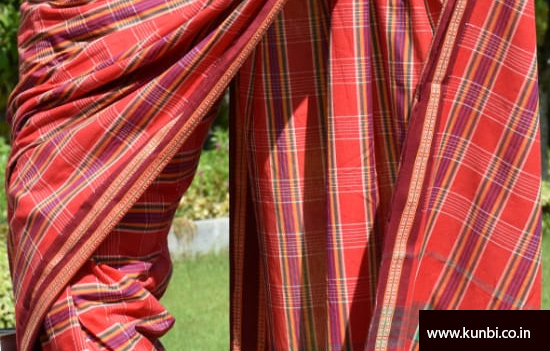
Goa
as a state has such rich culture and diversity. One of the many offerings of
this beautiful state is the Kunbi saree. A traditional handwoven cotton saree
which is made by the Kunbi and Gawda tribes in Goa. The saree had almost
vanished from the Goan cultural landscape till the time late designer Wendell
Rodericks revived the traditional weaving techniques. Now, the Kunbi is coming
into its own.
With
a deep red palette and stripes and checks, the Kunbi is shorter than the
regular sarees and is generally tied higher up too. The skirt is flared which
allows women to work in the fields effortlessly. These days, the Kunbi has
transitioned into the regular drape.
The
colours evolved with time. There was maroon, blue, and green. An indigo blue
was a regular sight at farms where women would spend the day. But red was the
colour of the soil, of the land, of life.
What
is so unique about Kunbi sarees?
Save
Kunbi saris
To see sari designs
The
purpose of this compilation is to document and promote. We have given credits
and reference links in this compilation along with third party links (to
promote). In case some are missed, it is not with malafide intent. Please
email full details to esamskriti108@gmail.com and we shall effect the change.
To see album of Paithani and Himroo Sarees in Paithan and Aurangabad
To read all
articles by author
To
read all articles on Traditional Indian Textiles of India
Author Trishna
Patnaik
is a self-taught
artist based in Mumbai, Trishna has been practising art for over 14 years. She
is now a full-time professional painter pursuing her passion to create and
explore to the fullest. She conducts painting workshops across India. She is
also an art therapist and healer who works with clients on a one to one basis.
Not to forget her quality writings on Indian Art and now Textiles for
esamskriti. She fancies the art of creative writing.